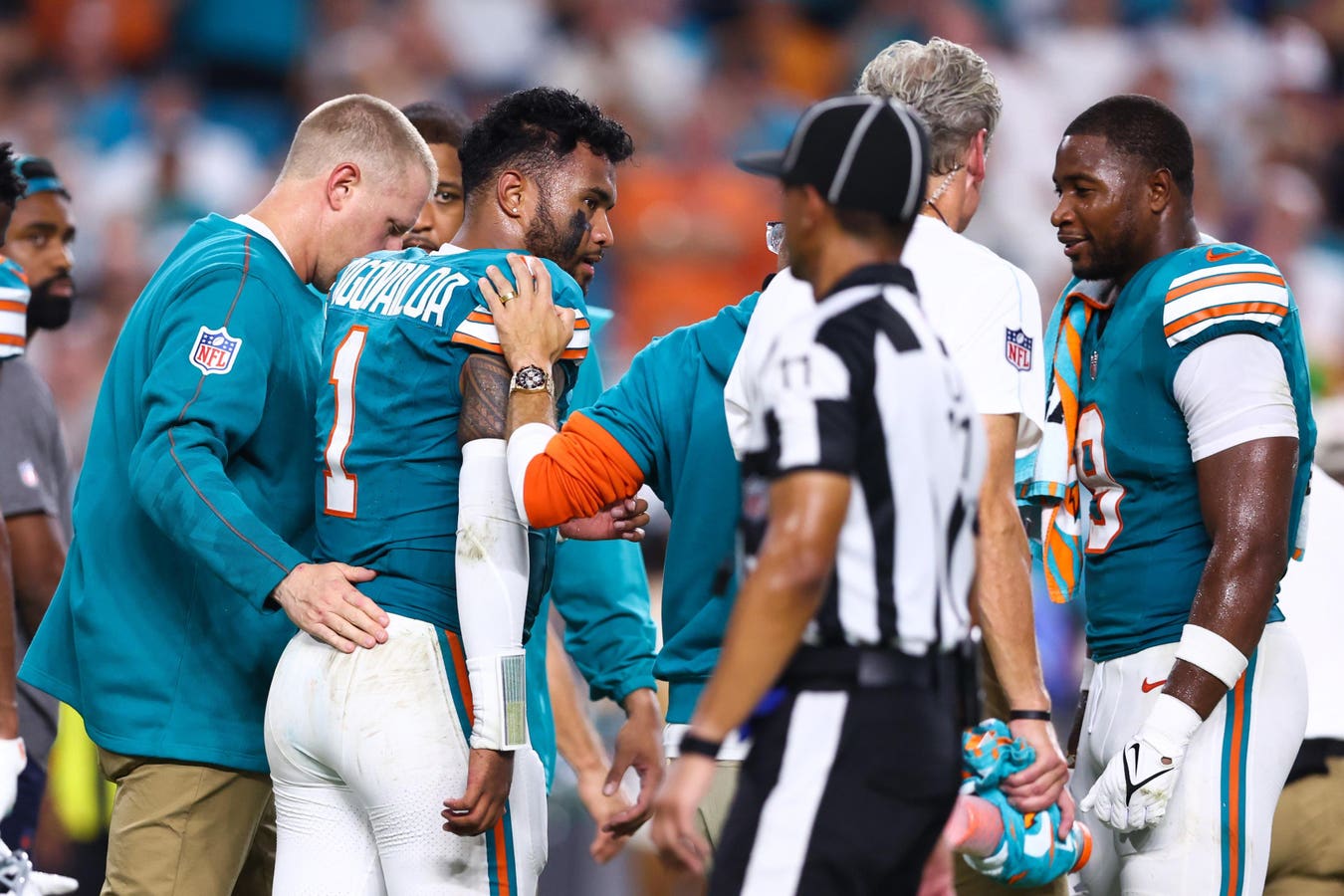As the saying goes, one can be accident, two can be coincidence but three is often a trend. Miami Dolphins quarterback Tua Tagovailoa was just diagnosed with the third concussion of his NFL career. This one came after his helmet—with his head in it—collided with Buffalo Bills safety Damar Hamlin’s body during the third quarter of their Thursday night football game. The Dolphins lost that game 31-10. But the team lost more than that as Tagovailoa’s return and perhaps even his career remains up in the air.
That’s because in the four prior NFL seasons since he was drafted in 2020 from the University of Alabama, Tagovailoa had already had two diagnosed concussions. The emphasis here is on the word “diagnosed” because who knows how many undiagnosed concussions he may have had. Your brain doesn’t necessarily say, “I’m concussed now” after a blow to the head has left it reeling.
His third diagnosed concussion came after the collision with Hamlin left Tagovailoa with a fencing response. That didn’t mean that Tagovailoa immediately erected a picket fence on the field. No, a fencing response is when after your brainstem gets rattled you hold your forearms in the air flexed or extended for a shorty time.
Trainers quickly ran on to the field and attended to the Dolphins QB for a few minutes. Although Tagovailoa was able to then stand up and walk off the field into the locker room under his own power, you’ve gotta worry about what all of it means going forward. Bad news comes in threes. Having had that many concussions makes you wonder when the next concussion may come.
Tagovailoa’s career hasn’t exactly been injury-free otherwise. In fact, he’s only had NFL season free of game-missing injuries. That being the 2023 NFL season. During the other seasons, a total of 14 games have gone by the wayside due to various ailments including concussions. Chances are that number will grow as Tagovailoa will have to at least go through the NFL concussion protocol before he is even able to return.
The protocol consists of the following five steps for the player to return-to-participation:
- Symptom-limited Activity: This is the rest-until-your-symptoms-resolve part of the protocol. It also includes the and-don’t-do-anything-that-worsens-your-symptoms kicker.
- Aerobic exercise: This can include dynamic stretching and balance training as well. But it should all be under the direct supervision of the football team’s medical staff. At the end of this phase, neurocognitive and balance testing should show that the player is back to baseline.
- Football-specific Exercise: This is the mimic-some-football-activities-but-don’t-actually-play-football phase. The player can practice with the team for up to 30 minutes at a time, mimicking football activities but again not actually doing football. All of this should be under close supervision.
- Club-based Non-contact Training Drills: This is the first are-you-ready-for-some-football phase with one key limitation. Everything has to be non-contact.
- Full Football Activity/Clearance: Once the team physician says that you can go back to contact football, you then need to be cleared by an Independent Neurological Consultant (INC), who is assigned to your team. Only after the INC has inked his or her approval can you then play in the next practice or game.
The NFL basically instituted a concussion protocol in 2011. That was only after years of players staying in or returning to games soon after they had gotten their “bells run,” which is a gentle way of saying injured their brains. In many of these cases in the past, players would keep playing even though they were still seeing stars, tweetie birds or whatever. Some reported not even remembering what happened during the ensuing plays.
A concussion is essentially a mild traumatic brain injury that affects brain function in some way. The altered brain function can come in the form of headaches, difficulty concentrating, memory lapses, balance problems, mood changes or sleep issues. The term “mild” may sound, well, mild. However, it’s all relative. A concussion certainly isn’t as severe as a life-threatening or permanently disabling traumatic brain injury. It isn’t something to simply to sneeze at, though. The symptoms from a concussion can persist. Plus, damage to the brain can add up over time to even more serious and debilitating conditions.
While Tagovailoa is sidelined, third-year quarterback Skylar Thompson will probably be at the helm. That’s unless the Dolphins go with third-stringer Tim Boyle. Or they could always sign another quarterback like former Dolphins QB Ryan Tannehill or even, who knows, someone like Tom Brady, perhaps?
But all of these questions should pale in comparison to the even bigger concern: Tagovailoa’s health. Each time you get another concussion, you are potentially causing more permanent or even progressive injury to your brain. And your brain is kind of freaking important. Tagovailoa, his family and his doctors will have to decide whether the risk of more significant brain injury is too high going forward to continue playing football. The third time is certainly no charm when it comes to concussions.
Read the full article here





